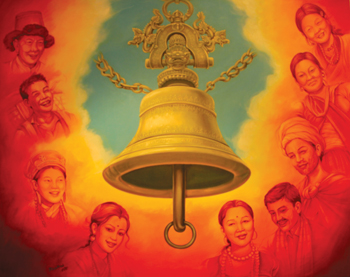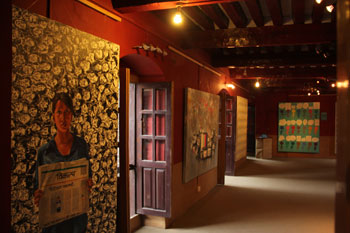An exhibition by 22 young artists give us an insight into what federalism means to educated youngsters of this country

PICS: AMIR JOSHI
“The sound of the bell represents the hope and the expectation of the Nepali people,” says Krishna Shrestha of his painting ‘Expectations’ (pictured above).
December 2007. Four months before Nepal was to hold its first Constituent Assembly election, the interim assembly proposed to amend interim constitution with a very permanent bill: Nepal was to become a federal republic, sentiments be damned.
Fast forward to mid-2013. One year since the CA was disbanded, federalism is still a controversial subject. Politicos wax rhetoric on the media, blame each other for their collective failure to write a constitution, and commentators follow suit. But what of the common Nepali man and woman on the street?
Supported by the United Nations Development Program, 22 young artists from the Kathmandu University School of Arts’ Fine Arts program went through a two-day workshop on federalism and came up with 22 paintings depicting the f word.
“The sound of the bell represents the hope and expectations of the Nepali people,” said Krishna Shrestha. In his painting, ‘Expectations’, a huge bell, like the one at Patan Darbar Square, hangs in the middle, garlanded by diverse faces from Nepal. Written across its rim is the word ‘federalism’ in the Newari script.

A total of 22 artists displayed their work at the exhibition which was supported by Kathmandu University School of Arts and UNDP.
Textual arrangements form the core of a lot of the paintings. Maybe this easy assimilation of the signifier and what should have been signified came subconsciously, because the common Nepali consumes all discussions on federalism in words: reports of one politico bashing another, columnists lobbying for and against, and the media itself taking sides. As such, the challenge of depicting this concept with swathes of colour has been skirted around by the artists by working on slogans, making ‘painting’ far too outdated as far as ‘art’ is concerned.
Never mind what federalism actually is (or isn’t), this exhibition succeeds in showing what federalism means to educated, urban, youngsters of this country and through this shows that the debate of federalism is centred in Kathmandu. If labelling federalism as the magic pill to cure Nepal’s condition is frightfully simple, projecting it in simplistic terms, as many of the artists are guilty of, is equally naïve but understandable.
For an exhibition that aimed to encourage serious discussions on federalism, there were no descriptions in Nepali, or any other local language of the artists’ ideas and approaches either. Perhaps the man who asked me what ‘LOL’ meant in chat language drifted into the gallery by accident? Absent also, as some commentators have already noted, is a debate on whether federalism is right or wrong.
One should touch the word ‘art’ with a pair of pliers these days, because the very definition of it is changing, as it does all the time. Does an artist provide honest observation of what he sees around him – “No why, just here,” as said the musician John Cage – or is he also supposed to provide tangible alternatives to an existing world? You decide.
Sunir Pandey
Video of behind the scenes of A federal life exhibition